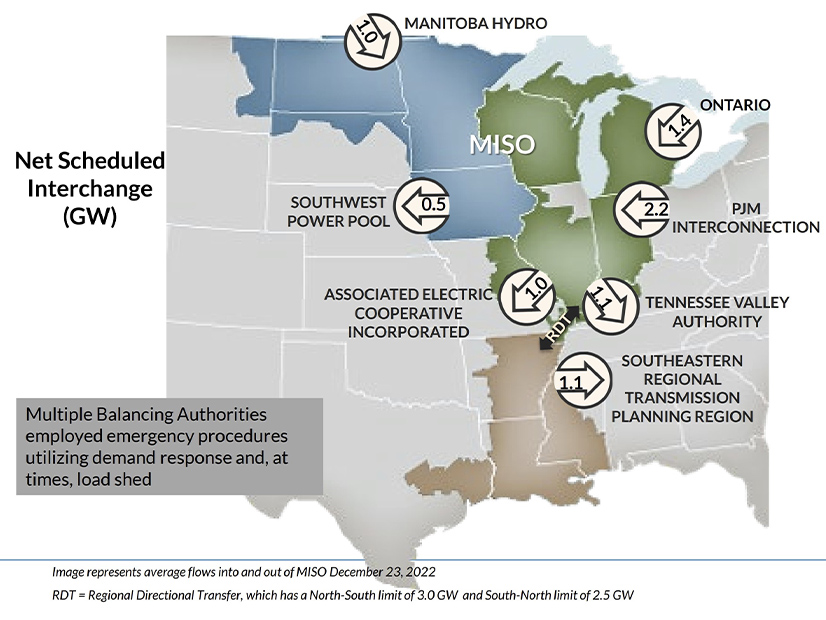MISO’s emergency declaration during the December winter storm has ignited a debate over whether the RTO should issue the alert to sustain its neighbors during extreme weather.
The grid operator in December made the emergency declaration as a wintry blast forced generation outages and higher than forecasted load in the system, pushing MISO into a three-hour maximum generation emergency to use its collection of load-modifying resources. It lifted a maximum generation warning for its South region a few hours before the evening peak. (See FERC, NERC Set Probe on Xmas Storm Blackouts.)
Jason Howard, MISO’s director of operations and risk management, said during a Reliability Subcommittee meeting Tuesday that staff and members “successfully managed through the event.”
However, he said the emergency was necessary to manage reliability while the RTO provided a “significant amount of exports” to its neighbors. Howard said staff was able to access additional capacity once they declared the emergency.
“There wasn’t a concern for capacity,” he said. “It was a matter of maintaining reliability and helping our neighbors out. [There was] no disruption of power to the MISO footprint.”
Howard said staff felt “very comfortable” with its capacity position ahead of the storm but that MISO and the industry “struggled” with forecasting an “unanticipated, drastic increase in demand. He said the gas generation fleet began depleting its supply as the system entered the evening peak on Dec. 23.
The emergency decision was ultimately necessary to “get at emergency reserve to maintain sufficiency and export upwards of 4 to 5 GW to help our neighbors,” he said, referring to SPP, the Tennessee Valley Authority, Associated Electric Cooperative, Inc., and the Southeast planning region. Howard said MISO had a responsibility to act because some of its neighbors were either facing or actively in load shed.
Director of Market Administration John Harmon said MISO was simply “assisting in an emergency,” as it would want to similarly be aided during an emergency.
Independent Market Monitor David Patton said he was still reviewing the event, adding that his initial conclusion is MISO should define what lengths it’s willing to go to in helping neighbors at the expense of its own markets.
“I will say that I totally appreciate and agree with the notion of wanting to help your neighbors, but you should be following your operating procedures,” Patton said. “The action that any RTO takes to help a neighbor can have serious financial impacts for customers.”
Stakeholders debated whether the grid operator should call on load-modifying resources to support non-firm exports. Patton said LMRs to support exports can trigger shortage pricing “that could cost millions.”
Hwikwon Ham, with the Minnesota Public Utilities Commission, pointed out that MISO’s risk assessments depend on imports from PJM and Canada to help keep the footprint afloat.
Minnesota Power’s Tom Butz said that had MISO not helped TVA during its emergency, the ramifications might have been more dire than a matter of “economic convenience.”
“This is a first for MISO,” Howard said of MISO’s status as a net exporter during the weather event. He said staff is going to have to determine its “operational philosophy” regarding emergency procedures in aiding neighboring regions.
MidAmerican Energy Co.’s Dennis Kimm argued that MISO’s issue in December wasn’t a gas supply one, but a timing problem. He said staff didn’t commit gas generators ahead of time, thus failing to provide them enough time to secure additional supplies. Kimm said gas purchases are especially challenging to procure during a holiday weekend and after 5 p.m.
Stakeholders asked whether MISO might consider clearing additional gigawatts of gas generation in the day-ahead market to serve as a buffer when extreme temperatures are forecasted.
Staff said MISO’s five-year plan includes devising methods to better manage uncertain conditions. Howard said they are working on providing its members better situational awareness so they can make more informed decisions on fuel procurement.
Howard acknowledged “issues” with sending notifications to market participants on Dec. 23 and said that the RTO is examining the communication issues to see what went wrong.
He said the winter storm’s high pressure kept MISO’s wind production high, unlike the February 2021 winter storm that brought in a low-pressure system. “These are unique differences that we have to manage that makes the planning challenging,” he said.
Staff said their first report on the storm contained only preliminary findings but promised more discussions on the system’s performance in December. The Resource Adequacy Subcommittee is planning to discuss the storm and its implications on capacity accreditation during its March meeting.
MISO issued a cold-weather alert and conservative operations instructions for its South region Dec. 22 through Dec. 26. It also declared conservative operations for its North and Central regions and two local transmission emergencies due to congestion on Dec. 23.
Staff said the South region’s warning was necessary because of a request by joint parties to the regional transmission transfer between the Midwest and South regions that MISO reduce flows across the link. Staff said they were still in discussions with the utilities to understand why the request was made.
Factoring in exports, MISO served peak demand of 111 GW on Dec. 23. Its load averaged 78 GW during December.


